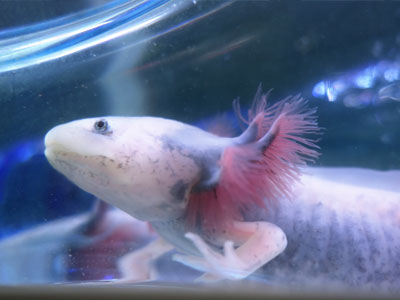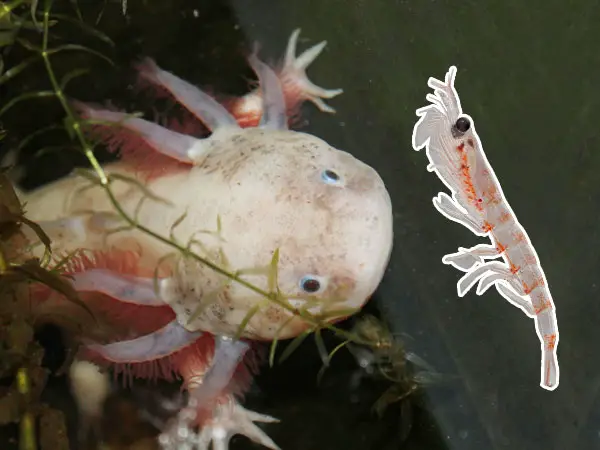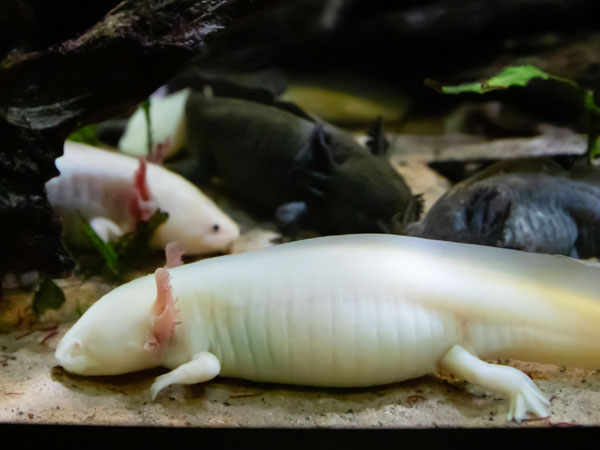
Worried that your axolotl may make a run for it? Well, it turns out that your fear may be founded.
Yes, axolotls can and will jump out of a tank that isn’t equipped with a hood or aquarium lid.
Open-top aquariums spell trouble for your axolotl pet as they may venture out of the aquarium, only to be found hours later all dried out.
Why do axolotls jump out of the tank? How to prevent axolotls from jumping out of their tank? And what to do if you find your axolotl out of its aquarium?
Axolotls remain aquatic for their entire lives, so it’s important not to remove them from their tank and prevent them from jumping out.
In this article, I explain why this happens and what to do in case you find your lotl out of its tank.
If you are new to keeping these interesting creatures, please read my axolotls care guide – where I cover every aspect of keeping axolotols in aquariums.
Why Do Axolotls Jump Out of Their Tank?
There are a couple of reasons why axolotls decide they want to “explore” the world outside of their tank. Unfortunately, most of these reasons are related to the conditions in which they’re kept.
Here are some of the reasons why axolotls jump out of the aquarium:
1. Poor Water Conditions
Axolotls attempting to jump or jumping out of the aquarium are usually doing so to escape poor water conditions.
Therefore, the first thing to consider examining is the water parameters in the tank. Is the water too warm or too cold? Is the water chemistry within the accepted parameters, or the water current too strong?
If you can’t find anything that’s wrong with the quality of your water, the problem may lie elsewhere.
2. Stress
Besides poor water conditions, other factors can also stress out your axolotls. For example, strong lights coupled with the fact that there are no dark corners in the aquarium, or a nippy tank mate can explain why your axolotl may jump out of the aquarium.
If there’s a tank mate that’s nipping or hurting your axolotl, you must separate them to prevent further health issues like fungal infections due to injuries and wounds.
3. Small Tank
Axolotls require a tank of at least 20-gallons, although a bit bigger may be even better. They may start out small, but they can grow to lengths of 15 to 45 cm (6 to 18 in).
If the tank is too small for your lotl, it’s not hard to understand why they may want to jump out of the aquarium.
4. Other Possible Reasons
It may be that you have an exemplary tank with exemplary water, and your axie still can’t stay put in its aquarium. The reason? You might just have a very active and very curious axolotl.
Another reason I keep hearing for axolotls making a break from their tanks is that they’re possibly undergoing metamorphosis.
However, axolotls generally don’t go through metamorphosis, in fact, that’s one of the traits that distinguishes them from other salamanders. Still, now and then, some axie may be the exception to the rule and may metamorphose.
This doesn’t really happen without the administration of hormones, which is usually done in scientific circles, so it’s unlikely that your axie is going through something like this.
You also shouldn’t attempt artificial metamorphosis (e.g. lowering the water level or by administering iodine) because chances are high that you’ll just end up killing your axie.
Preventing Axolotls from Jumping Out of Tank
Other than meeting the tank and water requirements of axolotls, investing in an aquarium hood or an aquarium lid will make sure you don’t have to worry about your axolotl jumping out of the tank and falling to its demise.
If your axolotl can jump out of its tank, it’s likely to suffer injuries from the fall, which can turn out to be fatal. What’s more, if you won’t notice your axolotl missing or notice it too late, it can dry out.
The surest way to prevent an axolotl from jumping out of the aquarium is to install an aquarium hood or an aquarium lid.
Both a lid or a hood comes with an easy-to-open compartment for feeding and can accommodate aquarium equipment easily. Plus, both options are affordable.
What to Do If Axolotl Jumps Out of Tank?
If you’re housing an axolotl in an open-top aquarium and you suddenly notice it’s missing, you must find it quickly and place it back into the water.
After they use up the little air that’s in their lungs, they can quickly dry out and die as a result, so it’s important to act quickly.
Meanwhile, you must also check water parameters (everything from temperature to ammonia, nitrites, pH, hardness and all that) to see if it’s something in the water that caused your axolotl to jump out.
Adjust any parameter that aren’t within the acceptable range (by doing a water change or adjusting pH or adjusting water temperature).
You must also check your axie for injuries, bleeding, curled tail or forward turned gills (signs of stress). If there are no signs of injury and your lotl is taking on food, going on with its normal routine, it may have gotten lucky.
You may need to call your vet to see how they can help if your axie is refusing food and looks injured.
If you don’t want this experience from repeating, you should install an aquarium top as soon as possible to prevent anything like this from happening ever again.
Conclusion
Axolotls can jump out of the aquarium for a variety of reasons, chief among them is poor water conditions.
Even if you have pristine water conditions that are in the ideal range for axolotls, you may still have an overactive axolotl that won’t shy away from exploring the outside of the tank, even if that means getting fatally injured from the jump, getting snatched away by a pet, or fatally drying out.
Monitoring water conditions (temperature, toxin levels, pH, hardness, etc.) and getting a cover for your tank are the only way to ensure that your axolotl stays safe in its aquarium.





It was so amazing thanks